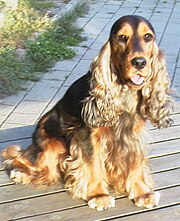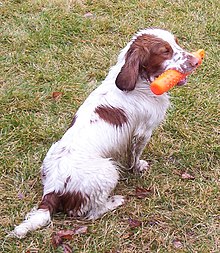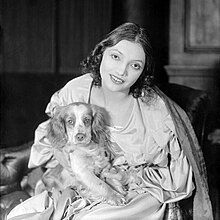English Cocker Spaniel
The English Cocker Spaniel is an active, good-natured, sporting dog[1] standing well up at the withers and compactly built.
During this time, the land spaniels became a bit more specialised and divisions among the types were made based upon weight.
When showing, the new Springer and Cocker, both were in the same class until The Spaniel Club created breed standards for each of the types.
In addition, the breed makes up three of the four winners who have won the title on more than one occasion with all three coming from H. S. Lloyd's Ware kennel.
Due to World War II, the English Cocker Spaniel managed to be the only breed to have won the title between 1938 and 1950, although the competition was only held on four occasions during that period.
They were originally divided from the English Cocker solely on a size basis but were bred over the years for different specific traits.
The American Kennel Club granted a separate breed designation for the English Cocker Spaniel in 1946.
Its eyes should be dark and its lobular ears should reach "a bit past" the tip of the nose when pulled forward.
[12] The breed standard of the United Kingdom's Kennel Club states that in solid colours, no white is allowed except for a small amount on the chest[11] and the American Kennel Club has standards for features including the expression, neck, topline, and body.
[citation needed] Of the solid colours, sable is considered rare and controversial and is classified by some countries as being a type of parti-colour on account of its mixed hair shafts.
[17] In addition, a silver/ash colour, usually associated with the Weimaraner dog, is considered genetically possible but is yet to be recorded by the United Kingdom's Kennel Club.
[19] With a good level of socialisation at an early age, Cocker Spaniels can get along well with people, children, other dogs and other pets.
When trained with a soft hand and plentiful rewards, the Cocker Spaniel will be an obedient and loving companion with a happy, cheerful nature.
[22] A 2024 UK study found a life expectancy of 13.3 years for the breed compared to an average of 12.7 for purebreeds and 12 for crossbreeds.
[24] A 1996 study made by the University of Cambridge surveying 932 English Cocker Spaniel households throughout Britain found owners to report higher aggression in different coloured English Cocker Spaniels depending on the scenario.
[30] The English Cocker Spaniel is predisposed to chronic hepatitis,[31] with one study finding the breed to be 2.78 times more likely to acquire the disease.
[33] This breed, like many others with origins as working dogs, has some genetic lines that focus on working-dog skills and other lines that focus on ensuring that the dog's appearance conforms to a breed standard; these are referred to as the "working" (or "field-bred") and "conformation" strains, respectively.
After World War II, Cocker Spaniels bred for pets and for the sport of conformation showing increased enormously in popular appeal, and, for a while, was the most numerous Kennel Club registered breed.
As is the case with the English Springer Spaniel, the working type has been bred exclusively to perform in the field as a hunting companion.
The 1930 play The Barretts of Wimpole Street by the Dutch/English dramatist Rudolf Besier also had Browning's red cocker spaniel as a central character.
An English cocker is prominently featured in several episodes of James Herriot's All Creatures Great and Small.










